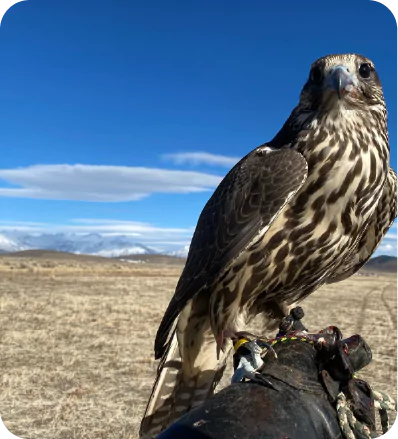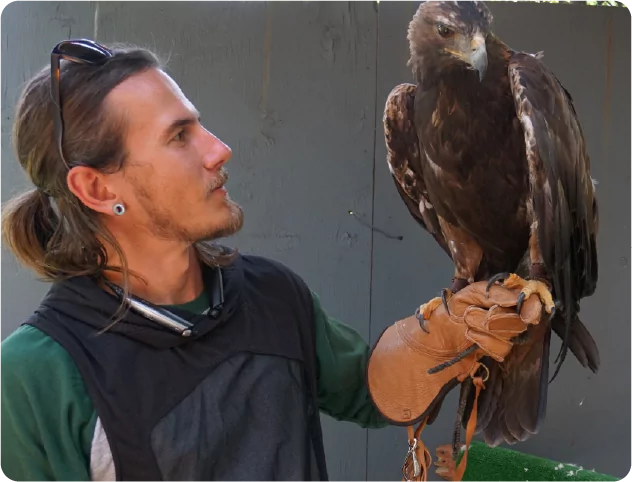How To Train a Falcon
- Build Up Trust
Build a relationship built on trust and respect by spending time with your falcon. - Start Your Tethered Training
To begin, tie the falcon to a perch to get used to you and its surroundings. - Use Positive Reinforcement
Reward desired actions, such as returning to the glove with sweets to help the falcon learn them. - Teach Basic Commands
Teach the falcon simple commands to establish control and obedience. - Free-Flight Training
Gradually introduce free-flight training in a controlled setting to improve the falcon’s flying ability and memory capacities. - Keep Practising
The falcon’s talents can be maintained with regular training sessions. It will also deepen your relationship. - Take Help From A Professional
Throughout the training process, seek the counsel and direction of seasoned falconers.


How to Choose the Falcons
Falcons, hawks, and owls are just a few of the birds employed in falconry. Every category has distinctive qualities and calls for various considerations.
- Hawks
Hawks are adaptive and flexible animals well-known for their superior hunting abilities. They have rounded beaks and broad wings. Hawks come in a variety of sizes. The Red-tailed Hawk, Harris’s Hawk, and Goshawk are three common hawk species used in falconry. Hawks live in various environments, including meadows, cities, and woods. Since they are generalist predators, these birds prey on small mammals, birds, and even reptiles. The Red-tailed Hawk is more significant than the Harris’s Hawk, which is smaller. - Falcons
Falcons are known for their exceptional speed and agility. They have sharp beaks and long, thin wings. The Peregrine Falcon, Gyrfalcon, and Saker Falcon are three common falcon species employed in falconry. Falcons usually live in open areas with wide-open spaces like deserts, mountains, and coastal regions. They are adept hunters who mainly pursue soaring birds. The enormous falcon is a peregrine, which is a medium-sized bird. Their primary food source is birds, with small animals as a supplement. - Owls
Owls are nocturnal raptors with distinctive abilities, including quiet flying and superior night vision. Falconry frequently employs barn owls, Eurasian eagle owls, and great horned owls. Owls have broad heads, eyes that face forward, and pointed claws. They are perfectly adapted for hunting small animals, birds, and insects. Owls live in various habitats, such as meadows, cities, and woods.
Ongoing Care and Maintenance of Falcons
Health
Monitor the falcon’s overall health. This includes its feathers, eyes, and behavior to ensure any issues are addressed promptly.
Diet
It’s important to give your pet a balanced diet consisting of high-quality food appropriate for their species. This should include fresh whole prey and, if necessary, vitamin supplements.
Clean Water
Ensure access to fresh water to hydrate the falcon.
Housing Facilities
Provide a spacious and secure aviary or mews that offer protection from extreme weather conditions and predators.
Relax and Exercise
Furnish the enclosure with suitable perches for the falcon to rest and exercise its wings.
Bathing and Grooming
Offer opportunities for the falcon to bathe. This helps maintain its plumage. Groom it regularly to remove debris.
Training
Continue training sessions to reinforce skills and stimulate the falcon’s mind through enrichment activities.
Vaccinations
Follow appropriate hygiene practices, including regular enclosure cleaning. This helps prevent disease transmission. Consult a vet regarding recommended vaccinations.
Regular Check-ups
Schedule routine visits with a qualified avian vet to assess the falcon’s health, address concerns, and administer necessary treatments or vaccinations.
Tips for Successful Falconry Training
Here are some tips for successful falconry training in Ogden:
- Develop trust and create a solid relationship with your falcon. Take your time and be consistent in your training methods.
- Keep training sessions brief and concentrated on retaining the falcon’s engagement. Try to minimize tiredness.
- Gradually go from simple to more challenging activities. Make sure the falcon is prepared for each new stage.
- Reinforce desired actions, such as returning to the glove and obeying instructions. Try using goodies and prizes.
- Talk with knowledgeable falconers or trainers for suggestions, direction, and other training strategies to improve your abilities and understanding.
Contact Us
